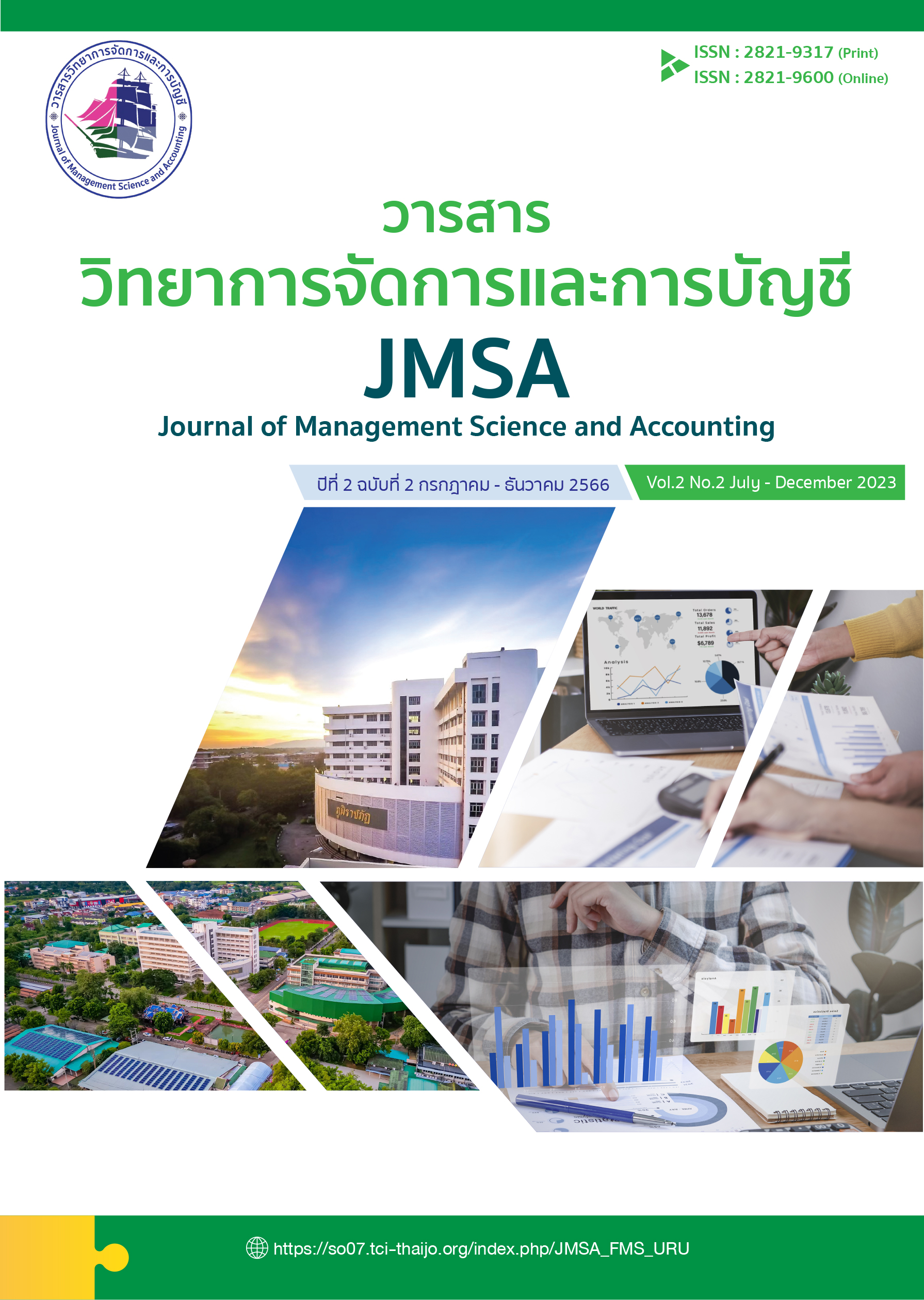Product Development to Improve the Elderly’s Quality of Life
Main Article Content
Abstract
This research aimed to apply a product development strategy to improve the elderly’s quality of life in Nam Cho municipality, Mae Tha district, Lampang province. This study was a qualitative, participatory action research. The key informants were 14 elderly members of all-purpose mat maker occupational group and representatives from the Local Community Development Office. The data were collected by in-depth interviews and focus group discussion. The data were recorded in interview forms, observation forms and memo forms. There were three stages of study as follows. Stage 1 includes analyses of community contexts, SWOT, elderly occupational group, products and consumer behavior, and a survey of trends; Stage 2 encompasses training sessions on product development, value addition, marketing strategies, and group management; Stage 3 covers product development, market expansion, implementation of cause-related and relationship marketing. A model was then created as a model to improve the elderly’s quality of life through product development. The findings were as follows. Firstly, product development and modification has led to a better quality of life of the elderly. Secondly, products as a central role for the occupational group should be prioritized over other marketing mix elements, and a variety of products should be developed as it helps enhance market expansion. Thirdly, the essential factors were elderly characteristics (health, age, skill, and ability) and consumer behavior (willingness to give support and donation). Fourth, the elderly’s quality of life could be determined by group relation, free time spending ways, extra income, access to supports, and contentment. Lastly, caused-related marketing is effective in expanding markets and establishing relationship with business allies.
Article Details

This work is licensed under a Creative Commons Attribution-NonCommercial-NoDerivatives 4.0 International License.
Articles published in the Journal of Management Science and Accounting Uttaradit Rajabhat University It is the copyright of Uttaradit Rajabhat University.
Articles published in Journal of Management Science and Accounting Uttaradit Rajabhat University Considered to be the personal opinion of the writer. The editorial board does not have to agree. Authors are responsible for their own articles.
Authors who publish agree to the following terms:
- Authors retain copyright and grant the journal right of first publication with the work simultaneously licensed under a Attribution-NonCommercial-NoDerivatives 4.0 International (CC BY-NC-ND 4.0) that allows others to share the work with an acknowledgment of the work's authorship and initial publication in this journal.
- Authors are able to enter into separate, additional contractual arrangements for the non-exclusive distribution of the journal's published version of the work (e.g., post it to an institutional repository or publish it in a book), with an acknowledgment of its initial publication in this journal.
- Authors are permitted and encouraged to post their work online (e.g., in institutional repositories or on their website) prior to and during the submission process, as it can lead to productive exchanges, as well as earlier and greater citation of published work.
References
กมลพร กัลยาณมิตร. (2565). การพัฒนาคุณภาพชีวิตผู้สูงอายุเปลี่ยนภาระเป็นพลังร่วมพัฒนาสังคม. วารสาร มจรพุทธปัญญาปริทรรศน์, 7(2), 31-46.
กองวิชาการและแผนงานเทศบาลตำบลน้ำโจ้. (2562). แผนพัฒนาท้องถิ่น (พ.ศ.2561-2565). ลำปาง: เทศบาลตำบลน้ำโจ้ อำเภอแม่ทะ จังหวัดลำปาง.
เขมิกา. (2561, 16 ตุลาคม). 6 เครื่องมือการทำการตลาด. https://blog.sogoodweb.com/Article/Detail/90366/6-เครื่องมือการทำการตลาด!!
คอทเลอร์, พี., เฮสเสนเคียล, ดี. และลี, เอ็น. อาร์. (2556). Good Works (การบริหารการตลาดและองค์กรยุคใหม่เพื่อโลกสดใส เพิ่มกำไรและความสำเร็จ) (ณงลักษณ์ จารุวัฒน์, ผู้แปล). กรุงเทพฯ: เนชั่นบุคส์.
จริยา ศิริพันธ์ และทวี รักสกุล. (2565). ประสิทธิผลในภารกิจส่งเสริมคุณภาพชีวิตผู้สูงอายุขององค์การบริหารส่วนจังหวัดชัยภูมิ. วารสารสหวิทยาการมนุษยศาสตร์และสังคมศาสตร์, 5(3), 1026-1039.
ชโรฌา กนกประจักษ์ และพัชนี เชยจรรยา. (2564). การพัฒนาโมเดลสมการเชิงโครงสร้างปัจจัยการสื่อสารที่มีอิทธิพลต่อการตัดสินใจบริจาคให้กับองค์กรไม่แสวงหาผลกำไร. วารสารการประชาสัมพันธ์และการโฆษณา, 14(2), 15-37.
ซิมเพิล เจอร์นี่. (2563, 29 กรกฎาคม). Cause Marketing คืออะไร. https://www.blockdit.com/posts/5f214d90b6f31f0c97d3f67e
ซีอีโอ วินเนอร์. (2565, 15 มีนาคม). ขั้นตอนในการขยายฐานลูกค้าของคุณ. https://www.seo-winner.com/Steps-to-expand-your-customer-base
ทาริกา สระทองคำ, อนงค์ ไต่วัลย์ และอมร ถุงสุวรรณ. (2565). รูปแบบการพัฒนาผลิตภัณฑ์ของกลุ่มวิสาหกิจชุมชนที่ตอบสนองความต้องการลูกค้าในยุคอนาคต. วารสารวิจัยมหาวิทยาลัยเวสเทิร์น มนุษยศาสตร์และสังคมศาสตร์, 8(1), 239-250.
เทศบาลตำบลน้ำโจ้. (2562, 14 มิถุนายน). ฐานข้อมูลสารสนเทศเทศบาลตำบลน้ำโจ้. https://sites.google.com/site/unamjocommunity/personal
นุสรา แสงอร่าม, วิจิตรา แซ่ตั้ง, ชิดชนก วงศ์เครือ และกัญญารัตน์ ไชยสงคราม. (6-7 สิงหาคม 2562). การใช้กลยุทธ์ผลิตภัณฑ์ของกลุ่มผู้สูงอายุ เขตเทศบาลตำบลน้ำโจ้ อำเภอแม่ทะ จังหวัดลำปาง [การนำเสนอภาคโปสเตอร์]. การประชุมวิชาและนำเสนอผลงานวิจัยระดับชาติครั้งที่ 11 “ถักทองานวิจัยท้องถิ่น ก้าวไกลสู่สากล” (1,300-1,306). นครราชสีมา: มหาวิทยาลัยราชภัฏนครราชสีมา.
ไทยพับลิก้า. (2562, 30 สิงหาคม). EIC เปิดผลสำรวจปี 60 คนไทยใจบุญ ใช้จ่ายเพื่อการกุศล ยอดบริจาค ถวายพระ-ไหว้เจ้า 6,200 บาทต่อครัวเรือนต่อปี. https://thaipublica.org/2019/08/scb-eic-thai-household-merit-spending/
นารายณ์ เหยาหยุน. (ม.ป.ป.). การพัฒนาผลิตภัณฑ์ใหม่และสาเหตุที่ทำให้ผลิตภัณฑ์ใหม่ล้มเหลว. https://slideplayer.in.th/slide/2084103/
บังอร สุวรรณมงคล. (2559, 17 สิงหาคม). สร้างยอดขาย ขยายตลาด อย่างมีกลยุทธ์ เขาทำกันอย่างไรนะ?. https://www.marketingoops.com/exclusive/how-to/build-market-revenue/
ปรีดี นุกูลสมปรารถนา. (2563, 05 พฤศจิกายน). การตลาดแบบ Relationship Marketing. https://www.popticles.com/marketing/what-is-relationship-marketing/
พวงทอง ไกรพิบูลย์. (2561, 2 ธันวาคม). ผู้สูงอายุ. https://haamor.com/ผู้สูงอายุ/
พัทธ์ธีรา สมทรง. (2021). ความสัมพันธ์ระหว่างบทบาทภาวะผู้นำเชิงกลยุทธ์ นวัตกรรมผลิตภัณฑ์ และพันธมิตรทางธุรกิจที่มีผลกระทบต่อความได้เปรียบในการแข่งขันของวิสาหกิจขนาดกลางและขนาดย่อมในเขตภาคเหนือตอนบน. วารสารมนุษยศาสตร์และสังคมศาสตร์มหาวิทยาลัยธนบุรี, 15(2), 91-102.
พีพี. (2562, 11 กันยายน). คนไหนคนไทยจะรู้ได้ไง ถ้ามีน้ำใจละคนไทยแน่นอน! ครัวเรือนไทย 96% ใช้จ่ายเพื่อการกุศล เงินบุญสะพัดกว่า 1.3 แสนล้าน. https://www.brandbuffet.in.th/2019/09/insight-thai-cosumer-spend-for-charity/
ยุพา ทองสุข, ดวงใจ วัฒนสินธุ์ และภรภัทร เฮงอุดมทรัพย์. (2562). ปัจจัยที่มีอิทธิพลต่อความผาสุกทางใจของผู้สูงอายุ. วารสารการพยาบาลจิตเวชและสุขภาพจิต, 33(1), 95-110.
ลงทุนแมน. 10 ประเทศใจบุญที่ชอบบริจาคเงินมากที่สุดในโลก. [รูปภาพ]. Facebook. https://www.facebook.com/longtunman/photos/a.113656345833649/647879932411285/?type=3&theater
วณัฐพงศ์ เบญจพงศ์. (2563). การใช้เวลาว่างเพื่อเตรียมพร้อมวิถีแห่งความสุขก่อนวัยสูงอายุ. วารสารศึกษาศาสตร์ปริทัศน์, 35(3), 1-10.
วรรธนะรัตน์ ไชยวงศ์, นพมาศ ใจเปี้ย, กรรณิการ์ ยศบุญสุข และธัญญาลักษณ์ จันทร์. (2564). การพัฒนาผลิตภัณฑ์แปรรูปจากกะลามะพร้าว. วารสารบัญชีปริทัศน์, 6(2), 23-35.
วิจิตรา ศรีสอน, สัณฐาน ชยนนท์, ทิฆัมพร พันลึกเดช และองค์อร สงวนญาติ. (2564). การพัฒนาคุณภาพชีวิตผู้สูงอายุ อำเภอค้อวัง จังหวัดยโสธร. วารสารการบริหารนิติบุคคลและนวัตกรรมท้องถิ่น, 7(2), 15-31.
วิทมา ธรรมเจริญ, นิทัศนีย์ เจริญงาม และนิตยา ทองหนูนุ้ย. (2562). ปัจจัยทำนายการมีคุณภาพชีวิตที่ดีของผู้สูงอายุในจังหวัดจันทบุรี. วารสารวิทยาศาสตร์และเทคโนโลยี มหาวิทยาลัยอุบลราชธานี, 21(2), 48-64.
สำนักงานกองทุนการสร้างเสริมสุขภาพ. (2556, 4 มีนาคม). เปิดโพลพฤติกรรมการให้.https://www.thaihealth.or.th/เปิดโพลพฤติกรรม-การให้/
สุภัคชัย ดำสีใหม่, ไพรัตน์ ฉิมหาด และเดโช แขน้ำแก้ว. (2565). แนวทางการพัฒนาคุณภาพชีวิตของผู้สูงอายุ. วารสารมหาจุฬาคชสาร, 13(1), 1-10.
เสกสรร มนทิราภา. (2021). การประยุกต์ใช้สังคหวัตถุธรรมกับความรับผิดชอบต่อสังคมขององค์กร. วารสารมจรสังคมศาสตร์ปริทรรศน์, 10(3), 360-370.
อังคณา ตาเสนา, ธีรศิลป์ กันธา, มัลลิกา ทองเอม และนิพิฐพนธ์ ฤาชา. (2565). การพัฒนาผลิตภัณฑ์ข้าวเกรียบของกลุ่มผู้สูงอายุบ้านห้วยกะโหลก ตำบลแม่ปะ อำเภอแม่สอด จังหวัดตาก. วารสารวิจัยมหาวิทยาลัยราชภัฏหมู่บ้านจอมบึง สาขามนุษยศาสตร์และสังคมศาสตร์, 10(1), 18-32.
อิราวัฒน์ ชมระกา ณัฐศิรี สมจิตรานุกิจ และกุลยา อุปพงษ์. (2565). ผลกระทบของส่วนประสมทางการตลาดต่อการตัดสินใจซื้อสมาร์ทโฟนของผู้บริโภควัยทำงานในเขตอำเภอเมืองจังหวัดอุตรดิตถ์. วารสารวิทยาการจัดการและการบัญชี, 1(1), 65–89.
เอกพล เคราเซ, นำชัย ศุภฤกษ์ชัยสกุล, ศศิพัฒน์ ยอดเพชร และอัจศรา ประเสริฐสิน. (2562). คุณภาพชีวิตของผู้สูงอายุ: ถอดรหัสจากผู้รู้และผู้เป็น. วารสารสังคมสงเคราะห์ศาสตร์, 27(2), 131-162.
Kotler, P. & Armstrong, G. (2018). Principles of Marketing. Harlow: Pearson Education Limited.
Kotler, P., Keller, K. L., Ang, S. H., Tan, C. T. & Leong, S. M. (2018). Marketing Management; An Asian Perspective. Harlow: Pearson Education Limited.
Osman, A., Othman, Y. H., Rana, S. M. S, Jin, L. Y. & Solaiman, M. (2016). Effectiveness of Promotional Tools to Influence the Purchase Decisions of Unsought Products: A Study on life insurance. The Social Sciences, 11(2), 87-92.
Schiffman, L. G. & Kanuk, L. (2010). Consumer Behavior (10th ed.). New Jersey: Pearson Education.
Smartbiz Team. (2020, September 30). Market Expansion Strategy: What You Need to Know. https://resources.smartbizloans.com/blog/business-marketing/market-expansion-strategy-what-you-need-to-know
Suttle, R. (2019, February 12). Growth Strategies in Business. https://smallbusiness.chron.com/growth-strategies-business-4510.html


